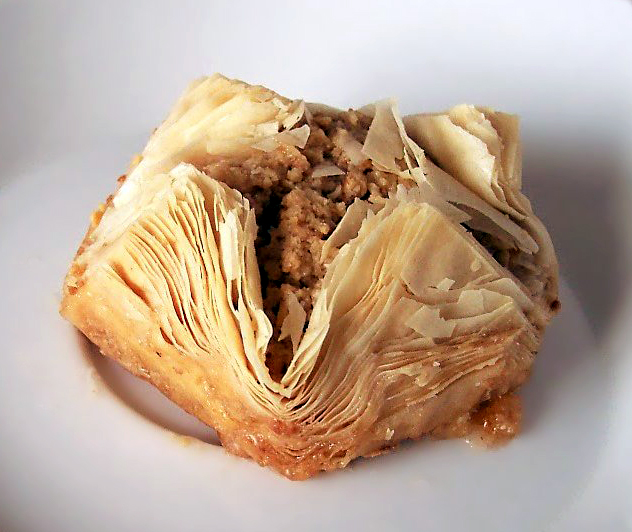Table of Contents > Recipe and Essay Baklava
Cooking Time: PT145M
Cooking Method: boil, simmer, bake
Category: dessert
Cuisine Type: Turkish
Servings: 20 servings
Related: dbPedia entity
Ingredients:
- 1 box store bought thin phllyo dough 2 1/3 sticks of butter 3 cups of walnut, chopped For the syrup: 3 cups of water 3 cups of sugar (if you like it really sweet go for 3 and a half cups) 2 tbsp lemon juice (to prevent crystallization of sugar)
Directions:
- Grease the baklava tray. The tray can be slightly smaller than phyllo sheets.
- Melt the butter.
- Place a layer of phyllo sheet at the bottom and drizzle 1 tbsp butter on top.
- Spread the half of the phyllo sheets on the tray, buttering them one by one.
- Sprinkle the ground walnuts on top of the middle layer.
- Cover the walnuts with the other half of phyllo sheets, again buttering every single one.
- When the sheets are finished, with the help of a knife push the edges inwards onto the try.
- Now the hardest part: cutting the baklava. Baklava has to be cut before it is baked. The most traditional cut is the diamond cut. But you can go for triangles or simple squares.
- For diamond cut. First find the sharpest knife in your kitchen and cut baklava into 4 or 5 equal pieces lengthwise. Then cut it diagonally at 1 inch intervals.
- Drizzle the remaining butter on top.
- Bake baklava in a preheated oven at 350F until golden brown.
- For the syrup, mix sugar and water and cook stirring constantly until sugar dissolves.
- First bring to a boil then let it simmer on low for ~20-25 minutes.
- Add lemon juice 10 minutes before you take it off the stove.
- Turn it off, and let it sit for 10-15 minutes.
- Baklava has to be cold when you pour the syrup. So, you can bake it before hand or start making the syrup as you take the baklava of the oven. On the other hand the syrup should neither be boiling hot nor cold. It will be at a good temperature to pour after 10-15 minutes off the stove.
- Pour the syrup on top and let it soak. Wait at least 1 but better 2 hours to cool and absorb the syrup.

Table of Contents > Recipe and Essay Tasty Turkish Tradition
There is no better medium to express culture than through food. Culinary preferences have long been a factor in shaping and distinguishing cultural and national identity. Hazal Ural, a 21-year-old Turkish exchange student, is a perfect example of this phenomenon. Growing up in Turkey, mealtime was not simply a time to satisfy hunger, but a social occasion where families, friendships, and tradition were strengthened, and Baklava was almost always the preferred dessert.
Hazal learned to cook Baklava by watching her mother and grandmother. In Turkey, the mother of the house traditionally prepares Baklava for holidays and social events. As a girl, Hazal always paid close attention at such occasions, and quickly learned her own techniques. The most traditional way to prepare Baklava is to make the phllyo dough by hand, a 24-hour process. "My Grandmother makes the best phllyo dough," says Hazal, "she never uses store bought dough, she always makes it by hand; it is much better than my mother's." Hazal recollects one holiday in particular where Baklava is the featured cuisine; her face lights up at the mere thought of it. Hazal describes a Catholic holiday that was celebrated by most families in Turkey (despite the country being predominantly Muslim). During this holiday, the country's youth visits elder relatives, who in turn provide sweets, which are almost always Baklava. The frequency and persistence with which Baklava is riddled throughout both Hazal's personal background and Turkish culture is astonishing. Baklava is truly a staple dish in Turkish culture.
The history of Baklava in Turkey is a colorful one. Though no one knows the true origin of the dessert, Hazal and other Turkish food enthusiasts maintain that Turkey, more specifically the city of Antep, is the birthplace of Baklava. From here, the dessert diffused all around Turkey. Each city has its own signature Baklava, and within each city, different families have their own signature Baklava. "In Turkey we have things that are like cafes, but they are entirely for Baklava, and you can get all kinds of Baklava," again Hazal's face lightens while she speaks, "and each family has a secret recipe that they don't tell anyone except their family." These family traditions are passed down for generations, creating a diversity of Baklava recipes, some hundreds of years old. Baklava is engrained in the depths of Turkish traditional heritage.
In addition to expressing cultural tradition back home, Hazal describes how it has affected her during her life in the U.S. At the annual international food bazaar held on Montana State University's campus, nationalities from all over the world gather to share the foods that are most significant to each cultural background. Every year Turkey, Greece, and Lebanon compete for the best food, and every year the main dish is Baklava. According to Hazal, Turkey has been the champion for the last few years running.
Baklava is not only a delicious pastry, but also a medium for expressing culture. Its roots go back to the roots of culture itself and are deeply ingrained in Turkish National Heritage.